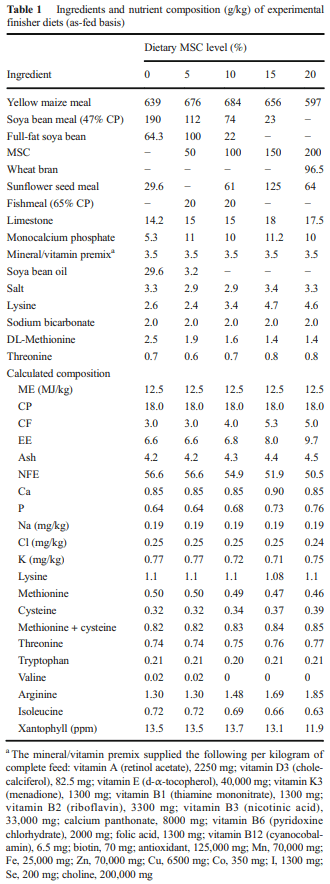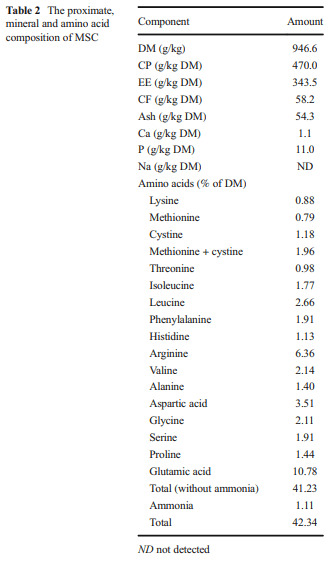The nutritive value of marula (Sclerocarya birrea) seed cake for broiler chickens: nutritional composition, performance, carcass characteristics and oxidative and mycotoxin status
This study was aimed at investigating the nutritive value of marula seed cake (MSC) as an alternative protein source for broilers. In a completely randomised design involving six replicate pens of five chickens assigned to each of five treatments, body weight gain (BWG), feed intake (FI), feed conversion efficiency (FCE) and carcass characteristics were measured in an experiment in which 150 28-day-old broilers were fed maize-based diets containing, respectively, 0, 5, 10, 15 and 20% MSC at finisher phase. The results showed MSC to be remarkably high in CP (470.0 g/kg DM) and EE (343.5 g/kg DM), with moderate CF (58.2 g/kg DM), ash (54.3 g/kg DM), Ca (1.1 g/kg DM) and P (11.0 g/kg DM). Whilst very poor in lysine, MSC was found to be rich in methionine, cyst(e)ine, arginine and glutamic acid; it also contains good levels of valine, glycine, threonine, isoleucine, leucine, histidine, phenylalanine, serine, proline and alanine. Also, it contained 85.24% oleic (OA), 9.65% palmitic and 5.11% stearic acids, with a high peroxide value and low levels of mycotoxins deoxynivalenol (DON) and T-2 toxin. BWG, FI and FCE of broiler chickens significantly decreased (P < 0.001) as the dietary level of MSC increased. Further, dietary MSC significantly decreased bird live weight at slaughter (P < 0.001), plucked weight (P < 0.001), dressed weight (P < 0.001) and weights of the liver (P < 0.001) and neck (P < 0.05). The results, therefore, demonstrate MSC to be a good source of CP, fat, Ca, P, amino acids (except lysine) and OA that can replace soya bean meal (SBM) in broiler diets. However, its use is currently limited by lipid peroxidation and presence of mycotoxins.
Keywords Marula seed cake, Broilers, Chemical composition, Performance, Carcass characteristics, Mycotoxins.






Acheampong-Boateng, O., Bakare, A.G. and Mbatha, K.R., 2016. The potential of replacing soyabean oil cake with macadamia oil cake in broiler diets, Tropical Animal Health and Production DOI 10.1007/s11250-016-1057-y
Akinnifesi, F.K., Leaky, R.R.B., Ajayi, O.C., Sileshi, G., Tchoundjeu, Z., Matakaala, P. and Kwesigga, F.R., 2008. Indigenous fruit trees in the tropics: domestication, utilisation and commercialisation, (CAB International, Wallingford, UK), pp. 210–212 & pp. 288–300.
ANU Forestry, 2001. Marula fruit. <http://www.anu.edu.au/Forestry/wood/nwfp/toesu/Toesu2.html (Accessed 15 April 2016).
Association of Official Analytical Chemists (AOAC)., 1993. Official Methods and Recommended Practices of the American Oil Chemist’s Society. D. Firestone (Ed.), AOAC Press, Illinois.
Association of Official Analytical Chemists (AOAC)., 2000. Official Methods of Analysis. Vol. I. 17th Ed., (Arlington, Washington DC, USA).
Association of Official Analytical Chemists (AOAC)., 2002. Official Method 996.06. Fat (Total, saturated, and unsaturated) in Foods. (Arlington, Washington DC, USA).
Baker, D.H., 2000. Nutritional constraints to use of soy products by animals. In: J.K. Drackley (Ed), Soy in Aminal Nutrition, (Federal Animal Science Society, Savoy, IL), pp. 1–12.
Banaszkiewicz, T., 2011. Nutritional value of soybean meal, soybean and nutrition. In: Prof. Hany El-Shemy (Ed), ISBN: 978–953–307-536-5, InTech, Available from: http://www.intechopen.com/books/ soybean-andnutrition/nutritional-value-of-soybean-meal.
Cabel, M.C., Waldroup, P.W., Shermer, W.D., and Calabotta, D.F., 1988. Effects of ethoxyquin feed preservative and peroxide level on broiler performance. Poultry Science, 67: 7125–1730.
Carrera, C.S., Reynoso, C.M., Funes, G.J., Martínez, M.J., Dardanelli, J. and Resnik, S.L., 2011. Amino acid composition of soybean seeds as affected by climatic variables, Pesquisa Agropecuária Brasileira, 46 (12), 1579–1587.
Chirwa, P.W. and Akinnifesi, F.K., 2008. Ecology and biology of Uapaca kirkina, Strychnos cocculoides and Sclerocarya birrea in Southern Africa. In: F.K. Akinnifesi, R.R.B. Leakey, O.C. Ajayi, G. Sileshi, Z. Tchoundjeu, P. Matakala and F.R. Kwesiga (Eds), Indigenous Fruit Trees in the Tropics: Domestication, Utilisation and Commercialisation, pp. 322–340 (CABI International, London).
Delles, R.M., Xiong, Y.L., True, A.D., Ao, T. and Dawson, K., 2014. Dietary antioxidant supplementation enhances lipid and protein oxidative stability of chicken broiler meat through promotion of antioxidant enzyme activity. Poultry Science, 93: 1561–1570. doi:10. 3382/ps.2013-03682.
Doll, S., Danicke, S., Ueberschar, K.H., Valenta, H., Schnurrbusch, U., Ganter, M., Klobasa, F. and Flachowsky, G., 2003. Effects of graded levels of Fusarium toxin contaminated maize in diets for female weaned piglets. Archives of Animal Nutrition, 57 (5): 311–334.
Enberg, R.M., Lauridsen, C., Jensen, S.K., and Jakobsen, K., 1996. Inclusion of oxidized vegetable oil in broiler diets: its influence on nutrient balance and on the antioxidative status of broilers. Poultry Science, 75: 1003–1011.
European Food Safety Authority (EFSA)., 2004. Opinion of the Scientific Panel on Contaminants in the Food Chain on a request from the Commission related to deoxynivalenol (DON) as undesirable substance in animal feed. EFSA Journal, 73: 1–42.
Feinberg, B. and McLaughlin, C.S., 1989. Biochemical mechanism of action of trichothecene mycotoxins. In: V.R. Beasley (Ed.), Trichothecene mycotoxicoses: pathophysiologic effects, pp. 27–35 (Vol. 1, CRC Press, Boca Raton).
Fink-Gremmels, J., 1999. Mycotoxins: their implications for human and animal health. Veterinary Quarterly, 21: 115–20.
Goldflus, F., Ceccantini, M. and Santos, W., 2006. Amino acid content of soybean samples collected in different Brazilian States—Harvest 2003/2004, Brazilian Journal of Poultry Science, 8 (2), 105–111
. Gouwakinnou, G.N., Lykke, A.M., Assogbadjo, A.E., and Sinsin, B., 2011. Local knowledge, pattern and diversity of use of Sclerocarya birrea, Journal of Ethnobiology and Ethnomedicine, 7: 8.
Hall, J.B., O’brien, E.M. and Sinclair, F.L., 2002. Sclerocarya birrea: a monograph. School of Agricultural and Forest Sciences Publication No. 19, (University of Wales, Bangor), p. 157.
Kerler, J., and Grosch, W., 1996. Odorants contributing to warmed-over flavour (WOF) of refrigerated cooked beef. Journal of Food Science, 61: 1271–1274.
Kubena, L.F., Huff, W.E., Harvey, R.B., Phillips, T.D., Rottinghaus, G.E., 1989. Individual and combined toxicity of deoxynivalenol and T-2 toxin in broiler chicks. Poultry Science, 68: 622–626.
Kurushima, H., Hayashi, K., Toyota, Y., Kambe, M. and Kajiyama, G., 1995. Comparison of hypocholesterolemic effects induced by dietary linoleic acid and oleic acid in hamsters, Atherosclerosis, 114 (2): 213–221.
Magagula, B.S., 2013. The effect of substituting soyabean meal with cold pressed marula (Sclerocarya birrea) seed cake as a protein source in broiler starter diet. B.Sc. Agric (Animal Science) Project Report, Department of Animal Science, Faculty of Agriculture, University of Swaziland.
Mamba, S.S., 2013. The effect of replacing soyabean meal with marula (Sclerocarya birrea) seed cake as a protein source in broiler finisher diet. B.Sc. Agric (Animal Science) Project Report, Department of Animal Science, Faculty of Agriculture, University of Swaziland.
Mariod, A.A., 2005. Investigations on the oxidative stability of some unconventional Sudanese oils, traditionally used in human nutrition, PhD theis, Münster University. Mariod, A.A. and Abdelwahab, S.I., 2012. Sclerocarya birrea (Marula), an African tree of nutritional and medicinal uses: a review, Food Reviews International, 28, 375–388
Mariod, A.A., Ali, A.O., Elhussein, S.A. and Hussien, I.H., 2005. Quality of proteins and products based on Sclerocarya birrea (Marula) seed, Sudan Journal of Science and Technology, 6, 184–192.
Martens, S.D., Tiemann, T.T., Bindelle, J., Peters, M. and Lascano, C.E., 2012. Alternative plant protein sources for pigs and chickens in the tropics—nutritional value and constraints: a review, Journal of Agriculture and Rural Development in the Tropics and Subtropics, 113 (2), 101–123.
McGill, J., McGill, E., Kamyab, A., and Firman, J.D., 2011. Effect of high peroxide value fats on performance of broilers in a normal immune state. International Journal of Poultry Science, 10 (3): 241–246.
Mdziniso, P.M., Dlamini, A.M., Khumalo, G.Z and Mupangwa, J.F., 2016. Nutritional evaluation of marula (Sclerocarya birrea) seed cake as a protein supplement in dairy meal, Journal of Applied Life Sciences International, 4 (3), 1–11, Article no. JALSI.23273.
Mills, P. A., Rotter, R. G. and Marquardt, R. R., 1989. Modification of the glucosamine method for the quantification of fungal contamination, Canadian Journal of Animal Science, 69, 1105–1106.
Minitab, 2000. Minitab Statistical Software, Release 13.1 for Windows (Minitab Incorporation™, USA).
Mlambo, V., Dlamini, B.J., Ngwenya, M.D., Mhazo, N., Beyene, S.T. and Sikosana J.L.N., 2011a. In sacco and in vivo evaluation of marula (Sclerocarya birrea) seed cake as a protein source in commercial cattle fattening diets, Livestock Research for Rural Development, 23 (5). http://www.lrrd.org/lrrd23/5/mlam23121.htm.
Mlambo, V., Dlamini, B.J., Nkambule, M.T., Mhazo, N. and Sikosana J.L.N., 2011b. Nutritional evaluation of marula (Sclerocarya birrea) seed cake as a protein supplement for goats fed grass hay, Tropical Agriculture (Trinidad), 88 (1), 35–43.
Moganedi, K., Sibara, M., Grobler, P. and Goyvaerts, E., 2011. An assessment of genetic diversity among marula populations using the amplified fragment length polymorphism (AFLP) technique, African Journal of Agricultural Research, 6 (4), 790–797.
Mojeremane, W., and Tshwenyane, S.O., 2004. The role of morula (Sclerocarya birrea): a multipurpose indigenous fruit tree of Botswana, Journal of Boilogical Sciences 4 (6): 771–775.
Moselhy, H.F., Reid, R.G., Yousef, F. and Boyle, S.P., 2013. A specific, accurate, and sensitive measure of total plasma malondialdehyde by HPLC, Journal of Lipid Research, 54: 852–858.
Muhammad, S., Hassan, L.G., Dangoggo, S.M., Hassan, S.W., Umar, K.J. and Aliyu, R.U., 2011a. Nutritional and anti-nutritional composition of Sclerocarya birrea seed kernel, Studia Universitatis BVasile Goldis^, Seria Stiintele Vietii, 21 (4), 693–699.
Muhammad, S., Hassan, L.G., Dangoggo, S.M., Hassan, S.W., Umar, K.J. and Aliyu, R.U., 2011b. Acute and sub-chronic toxicity studies of kernel extract of Sclerocarya birrea in rats, Science World Journal, 6 (3), 11–14.
Nahashon, S.N. and Kilonzo-Nthenge, A.K., 2011. Advances in soybean and soybean by-products in monogastric nutrition and health, Soybean and Nutrition, Prof. Hany El-Shemy (Ed.), ISBN: 978- 953-307-536-5, InTech, http://www.intechopen.com/books/ soybean-and-nutrition/advances-in-soybeanand-soybean-byproducts-in-monogastric-nutrition-and-health.
National Research Council (NRC), 1994. Nutrient requirements of poultry. 9th edition. (National Academic Press, Washington, DC).
Nyoka, B.I., Chanyenga, T., Mng’omba, S.A., Akinnifesi, F.K. and Sagona, W., 2015. Variation in growth and fruit yield of populations of Sclerocarya birrea (A. Rich.) Hochst, Agroforestry Systems, 89, 397–407.
Racanicci, A.M., Menten, J.F.M., Regitano-D’arce, M.A.B., Torres, E.A.F.S., Pino, L.M. and Pedroso, A.A., 2008. Dietary oxidized poultry offal fat: broiler performance and oxidative stability of thigh meat during chilled storage. Brazilian Journal of Poultry Science, 10: 29–35.
Rajiur Rahman, S.M., 2012. Documentation of good practices for family poultry development in Swaziland. Report prepared for the IFAD funded FAO Project BSmallholder Poultry Development^ (GCP/ INT/197/IFA). http://www.fao.org/3/a-aq624e.pdf (Accessed 02 June 2016).
Ramachandran, S., Singh, S.K., Larrhoche, C., Soccol, C.R. and Pandey, A., 2007. Oilcakes and their biotechnological applications—a review, Bioresource Technology, 98, 2000–2009.
Schuhmacher-Wolz, U., Heine, K., Schneider, K., 2010. Report on toxicity data on trichothecene mycotoxins HT-2 and T-2 toxins. CT/ EFSA/CONTAM/2010/03. Available at: http://www.efsa.europa.eu/ en/supporting/doc/65e.pdf. Accessed March 04, 2017.
Siyaya, B.J. and Masuku, M.B., 2013. Determinants of profitability of indigenous chickens in Swaziland, Business and Economic Research 3 (2): 205–2017.
VDLUFA, 2007. Verband Deutscher Landwirtschaftlicher Unterschungsund Forschungsanatalten. Handbuch der Landwirtschaftlichen Ve r s uc h s - u n d U nte r s u c h u n g smet h o di k (VDLUFA Methodenbuch), Bd. III. Die Chemische Untersuchung von Futtermitteln. VDLUFA-Verlag. Darmstadt.
Wairagu, N.W., Kiptoo, J., and Githiomi, J.K., 2013. Nutritional assessment of Sclerocarya birrea (amarula) fruit from Kenya, International Journal of Current Research, 5 (5), 1074–1078.
World Bank Group., 2015. Ending poverty and hunger by 2030: an agenda for the global food system. 2nd edition. http://www-wds. worldbank.org/external/default/WDSContentServer/WDSP/IB/ 2015/06/03/090224b082eed2bb/2_0/Rendered/PDF/ Ending0poverty0e0global0food0system.pdf (Accessed 02 June 2016).
Wu, Q., Wang, X., Yang, W., Nussler, A.K., Xiong, L., Kuc?a, K., Dohnal, V., Zhang, X., Yuan, Z., 2014. Oxidative stress-mediated cytotoxicity and metabolism of T-2 toxin and deoxynivalenol in animals and humans: an update. Archives of Toxicology, 88: 1309–1326






